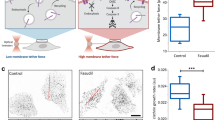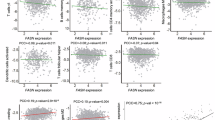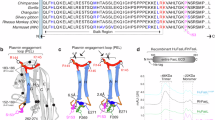Abstract
Fas ligand (FasL) is expressed on some cancers and may play a role in the immune evasion of the tumour. We used immuno-histochemistry to study the expression of Fas and FasL in tissue samples from breast cancer patients, as well as normal breast tissue. Our results show that Fas and FasL are co-expressed both in normal tissue and in breast tumours. Fas and FasL mRNA were expressed in fresh normal and malignant breast tissue, as well as cultured breast epithelium and breast cancer cell lines. Flow cytometry analysis of live cells failed to detect FasL on the surface of normal or malignant breast cells; however, both stained positive for FasL after permeabilization. Fas was detected on the surface of normal breast cells and T47D and MCF-10A cell lines but only intracellularly in other breast cell lines tested. Neither normal breast epithelium nor breast cell lines induced Fas-dependent apoptosis in Jurkat cells. Finally, 20 tumour samples were stained for apoptosis. Few apoptotic cells were detected and there was no increase in apoptotic cells on the borders between tumour cells and lymphocytes. We conclude that FasL is expressed intracellularly in both normal and malignant breast epithelium and unlikely to be important for the immune evasion of breast tumours. © 2000 Cancer Research Campaign http://www.bjcancer.com
Similar content being viewed by others
Article PDF
Change history
16 November 2011
This paper was modified 12 months after initial publication to switch to Creative Commons licence terms, as noted at publication
References
Baskar S, Clements VK, Glimcher LH, Nabavi N and Ostrand-Rosenberg S (1996) Rejection of MHC class II-transfected tumor cells requires induction of tumor-encoded B7-1 and/or B7-2 costimulatory molecules. J Immunol 156: 3821–3827
Bellgrau D, Gold D, Selawry H, Moore J, Franzusoff A and Duke RC (1995) A role for CD95 ligand in preventing graft rejection. Nature 377: 630–632
Bennett MW, O'Connell J, O'Sullivan GC, Brady C, Roche D, Collins JK and Shanahan F (1998) The Fas counterattack in vivo: apoptotic depletion of tumor-infiltrating lymphocytes associated with Fas ligand expression by human esophageal carcinoma. J Immunol 160: 5669–5675
Chappell DB, Zaks TZ, Rosenberg SA and Restifo NP (1999) Human melanoma cells do not express Fas (Apo-1/CD95) ligand. Cancer Res 59: 59–62
Chouaib S, Asselin-Paturel C, Mami-Chouaib F, Caignard A and Blay JY (1997) The host-tumor immune conflict: from immunosuppression to resistance and destruction. Immunol Today 18: 493–497
Garrido F, Ruiz-Cabello F, Cabrera T, Perez-Villar JJ, Lopez-Botet M, Duggan-Keen M and Stern PL (1997) Implications for immunosurveillance of altered HLA class I phenotypes in human tumours. Immunol Today 18: 89–95
Griffith TS, Brunner T, Fletcher SM, Green DR and Ferguson TA (1995) Fas ligand-induced apoptosis as a mechanism of immune privilege. Science 270: 1189–1192
Hahne M, Rimoldi D, Schröter M, Romero P, Schreier M, French LE, Schneider P, Bornard T, Fontana A, Lienard D, Cerottini JC and Tschopp J (1996) Melanoma cell expression of Fas (Apo-1/CD-95) ligand: implication for Tumor immune escape. Science 274: 1363–1366
Iwamoto M, Koji T, Makiyama K, Kobayashi N and Nakane PK (1996) Apoptosis of crypt epithelial cells in ulcerative colitis. J Pathol 180: 152–159
Jerome KR, Barnd DL, Bendt KM, Boyer CM, Taylor-Papadimitriou J, McKenzie IF, Bast RC, Jr and Finn OJ (1991) Cytotoxic T-lymphocytes derived from patients with breast adenocarcinoma recognize an epitope present on the protein core of a mucin molecule preferentially expressed by malignant cells. Cancer Res 51: 2908–2916
Kontny HU, Lehrnbecher TM, Chanock SJ and Mackall CL (1998) Simultaneous expression of Fas and nonfunctional Fas ligand in Ewing's sarcoma. Cancer Res 58: 5842–5849
Leithäuser F, Dhein J, Mechtersheimer G, Koretz K, Brüderlein S, Henne C, Schmidt A, Debatin K-M, Krammer PH and Möller P (1993) Constitutive and induced expression of APO-1, a new member of the nerve growth factor/tumor necrosis factor receptor superfamily, in normal and neoplastic cells. Laboratory Investigation 69: 415–429
Nagata S (1997) Apoptosis by death factor. Cell 88: 355–365
Niehans GA, Brunner T, Frizelle SP, Liston JC, Salerno CT, Knapp DJ, Green DR and Kratzke RA (1997) Human lung carcinomas express Fas ligand. Cancer Res 57: 1007–1012
O'Connell J, Bennett MW, O'Sullivan GC, Collins JK and Shanahan F (1999a) The Fas counterattack: cancer as a site of immune privilege. Immunol Today 20: 46–52
O'Connell J, Bennett MW, O'Sullivan GC, O'Callaghan J, Collins JK and Shanahan F (1999b) Expression of Fas (CD95/APO-1) ligand by human breast cancers: significance for tumor immune privilege. Clin Diagn Lab Immunol 6: 457–463
O'Sullivan C and Lewis CE (1994) Tumour-associated leucocytes: friends or foes in breast carcinoma. J Pathol 172: 229–235
Rensing-Ehl AK, Frei B, Flury B, Matiba SM, Mariani M, Weller P, Aebischer PH & Krammer Fontana A (1995) Local Fas/APO-1 (CD95) ligand-mediated tumor cell killing in vivo. Eur J Immunol 25: 2253
Russo J and Russo I (1987) Development of the human mammary gland. In: Neville M, Daniel C (eds) The mammary gland: development, regulation and function. Plenum Press: New York, pp 625
Smith D, Sieg S and Kaplan D (1998) Aberrant detection of cell surface Fas ligand with anti-peptide antibodies. J Immunol 160: 4159
Srivastava MD and Srivastava BI (1999) Soluble Fas and soluble Fas ligand proteins in human milk: possible significance in the development of immunological tolerance. Scand J Immunol 49: 51–54
Stewart THM and Tsai SCJ (1993) The possible role of stromal cell stimulation in worsening the prognosis of a subset of patients with breast cancer. Clin Exp Metastasis 11: 295–305
Strand S, Hofmann WJ, Hug H, Müller M, Otto G, Strand D, Mariani SM, Stremmel W, Krammer PH and Galle PR (1996) Lymphocyte apoptosis induced by CD95 (APO-1/Fas) ligand-expressing tumor cells – a mechanism of immune evasion. Nature Medicine 2: 1361–1366
Whiteside TL, Miescher S, Hurlimann J, Moretta L and von Fliedner V (1986) Clonal analysis and in situ characterization of lymphocytes infiltrating human breast carcinomas. Cancer Immunol Immunother 23: 169–178
Xerri L, Devilard E, Hassoun J, Mawas C and Birg F (1997) Fas ligand is not only expressed in immune privileged human organs but is also coexpressed with Fas in various epithelial tissues. Mol Pathol 50: 87–91
Author information
Authors and Affiliations
Rights and permissions
From twelve months after its original publication, this work is licensed under the Creative Commons Attribution-NonCommercial-Share Alike 3.0 Unported License. To view a copy of this license, visit http://creativecommons.org/licenses/by-nc-sa/3.0/
About this article
Cite this article
Ragnarsson, G., Mikaelsdottir, E., Vidarsson, H. et al. Intracellular Fas ligand in normal and malignant breast epithelium does not induce apoptosis in Fas-sensitive cells. Br J Cancer 83, 1715–1721 (2000). https://doi.org/10.1054/bjoc.2000.1506
Received:
Revised:
Accepted:
Published:
Issue date:
DOI: https://doi.org/10.1054/bjoc.2000.1506
Keywords
This article is cited by
-
Tumour Fas ligand:Fas ratio greater than 1 is an independent marker of relative resistance to tamoxifen therapy in hormone receptor positive breast cancer
Breast Cancer Research (2002)
-
Countering the 'counterattack' hypothesis
Nature Medicine (2001)



